Over 100,000 students appear for the GRE test every year in India. This number is huge. For instance, in 2022-23, 113,304 students took the GRE test. This was even higher than the number of GRE test takers in the USA for that year.
If you’re preparing for the GRE, you’ll need to be aware of the ever-changing nature of the test.
For instance, from September 2023, the GRE has changed into a more compact test format, without sacrificing thoroughness.
Also, you get your results faster, which means you can plan your next steps sooner or even retake the test to boost your score if needed.
This article will cover everything you need to know about the GRE in 2024.
Also Read: Top Exams For Studying Abroad [Comprehensive Guide]
What is the GRE exam?
The GRE full form is the “Graduate Record Examination.”
This exam is a prerequisite for applying to a master’s program or certain MBA and professional courses at the graduate level. The test is conducted by the Educational Testing Service (ETS).
It is a standardized test that is a key requirement for applicants to graduate-level programs, particularly in the United States and many other countries.
The GRE is designed to measure your abilities in areas like:
- Verbal Reasoning
- Quantitative Reasoning
- Analytical Writing
These skills reflect your potential for success in various advanced academic settings.
The GRE test comes in two main forms:
- GRE General Test
- GRE Subject Test
GRE General Test
The GRE General Test is created and administered by the Educational Testing Service (ETS). It measures your analytical writing, quantitative ability, and verbal reasoning skills.
ETS has made the GRE more accessible by offering computer-based tests and GRE at Home test formats.
Here’s a breakdown of the formats available for the GRE General Test:
GRE General Computer-Based Test
This is the most common format conducted at designated test centers worldwide. It uses computer technology and is available in all countries with internet access and appropriate computer facilities.
GRE General Test at home
This format allows you to take the GRE from the comfort of your home, provided you meet certain system requirements set by ETS. This option ensures the safety and convenience of test-takers and is available under specific conditions.
GRE Subject Test
The GRE Subject Test evaluates your knowledge in particular fields such as Chemistry, Physics, Psychology, or Mathematics. Graduate programs often require this test to assess technical skills in a specific discipline more deeply.
Both formats are for different purposes and have different preparation methods. Hence, choosing the right test format is crucial to level your preparation and set you up for success.
Additionally, you can retake a GRE Subject Test as frequently as once every 14 days.
Also Read: GRE Exam Dates in 2025: All Important Dates for GRE Exam
What is the GRE test on paper?
There is no GRE test on paper or a GRE paper-based test available in India. Indian students must take the GRE general test at computer-based test centers or online from home. However, students from Puerto Rico, American Samoa, and other remote US territories have the option to take the GRE as a paper-based test due to limited access to testing equipment and internet services.
GRE exam eligibility 2025
There are no specific academic qualifications to take the GRE. However, there are some conditions you must abide by to take the GRE exam to study master’s.
Let us look into the GRE eligibility in detail:
- You must be 18 years and above to write the GRE test to study abroad
- If your age is more than 16 years and less than 18, you’ll require a guardian or parent to fill a consent form
- You must have an official ETS account
- You must pay GRE fees and complete the registration process before applying
- If you’re differently-abled, you must submit a specific form in the ETS bulletin to arrange the necessary accommodations or adjustments for your convenience.
Home testing eligibility:
- Candidates must sit in a quiet, well-lit room for the GRE at-home exam. The test cannot be taken in informal settings, such as on a bed.
GRE exam fee 2025
When preparing to apply for the GRE, it’s crucial to factor in these costs as part of your overall planning.
Here’s a detailed breakdown of the GRE fees in India for 2024, which covers everything from the basic test fee to additional charges for special services.
Standard test fees
GRE General Test
The fee for taking the GRE General Test in India is ₹22,550. This fee covers the test administration and the provision of your scores to the institutions you designate.
GRE Subject Test
If you are taking a GRE Subject Test, which is specific to subjects like Physics, Chemistry, or Mathematics, the fee is ₹14,500. This test is often required for specialized graduate programs.
Special handling fees
Sometimes, plans change, or you might need additional services. Here’s what you might pay for these extra requests:
- Rescheduling your test: ₹5,000
- Changing your test center: ₹5,000
- Additional score reports: If you must send score reports to more than the standard four institutions, each additional report costs ₹2,900.
- Score review for Analytical Writing Section: ₹5,900
- Score reinstatement: If you previously canceled your scores and wish to reinstate them, the fee is ₹5,000.
- Returned payment fee: If a payment is returned for any reason, such as insufficient funds, the fee is ₹2,900.
ETS offers a variety of payment options to pay GRE fees in India.
- You can pay using Visa, MasterCard, and American Express credit cards, which are universally accepted.
- Candidates can use UPIs like phone pay and Google and Bharat QR payments
Scoring method and validity
ETS conducts extensive research, including surveys and data analysis, to support the validity of the GRE.
They regularly take feedback from the graduate community, including business and law schools, to continuously improve test quality.
The total score for the GRE General Test ranges from 260 to 340.
Notes:
- You can retake the GRE General Test once every 21 days but no more than five times within any continuous rolling 12-month period (365 days). This rule holds even if you decide to cancel your scores from a previously taken test.
- The GRE scores are valid for 5 years from the day your results are announced.
Now, let’s understand the scoring at a section level.
| Section | Score scale |
| Verbal Reasoning | 130–170, in 1-point increments |
| Quantitative Reasoning | 130–170, in 1-point increments |
| Analytical Writing | 0–6, in half-point increments |
Each section has a different scoring method depending on the nature of the questions. Here’s a section-by-section explanation of each section’s scoring method.
Verbal Reasoning and Quantitative reasoning
These sections are section-level adaptive. This means that your performance in the first section, which is verbal reasoning, determines the difficulty level of the second section, which is quantitative reasoning within each subject area.
The raw score, the number of correct answers, is converted to a scaled score through a process known as equating.
This method accounts for slight variations in difficulty among different test versions.
Analytical Writing
This section is evaluated by trained human raters and a software program called e-rater. At least one human rater and the e-rater score each essay independently.
If the scores from the human rater and the e-rater are closely aligned, the average becomes the final score for that essay.
However, if there is a significant discrepancy between the human and e-rater scores, a second human rater evaluates the essay, and the final score is the average of the two human scores.
Note: To prepare for GRE can be stressful, particularly when you don’t have an academic background in the key areas of the GRE exam syllabus (which we cover in the next section). It helps to work towards a target GRE score that can get you admission in the universities of your choice. For this, SelectRight can be a huge help.
Also Read: Understanding Your GRE Score: Result, How to Check, Validity & More
What is SelectRight?
It’s an AI powered platform that searches through 15,000+ programs and universities, and shortlists the best-matches for you, based on your academic and financial details. You can also understand their GRE score requirements, which can help you prepare in a structured manner, without the stress.
GRE Syllabus and exam pattern
Understanding the syllabus and exam pattern helps you manage time and tackle the test strategically.
Here’s the exam pattern for the GRE General Test, presented in a table format for clarity:
| Section | Format | Duration | Number of Questions |
| Analytical Writing | Analyze an issue | 30 minutes | 1 task |
| Verbal Reasoning | Multiple-choice | 41 minutes | Section 1: 12 questions
Section 2: 15 questions |
| Quantitative Reasoning | Multiple-choice | 47 minutes | Section 1: 12 questions
Section 2: 15 questions |
As per the latest structure of the GRE, effective September 22, 2023, the total test time was shortened to approximately 1 hour and 58 minutes.
Note: GRE offers you the flexibility to skip questions within a section, go back and change answers, and choose which questions within a section you want to answer first.
Now let’s understand the format at a section level.
Analytical writing
This section measures your critical thinking and analytical writing skills. It has one ‘Analyze an issue’ task, which is timed for 30 minutes.
You’ll need to write an essay expressing your views on an issue, analyze its complexity, and develop an argument. It requires essay-based answers so you write your arguments down in the basic word processor provided by the ETS.
.
Verbal reasoning

This section tests your ability to understand and interpret written material. The total time allocated for the Verbal Reasoning section is 47 minutes.
It is divided into two subsections. The first subsection involves answering questions by reading passages and the second subsection requires you to read, interpret, and complete the sentences.
- Reading Comprehension: These questions ask you to read passages and answer the questions of the passages.
- Text Completion: You will fill in the blanks in short passages with appropriate words or phrases.
- Sentence Equivalence: You must select two words that best complete a sentence and yield similar meanings.
Quantitative reasoning:

This section evaluates your basic math skills and ability to analyze data and draw conclusions using reasoning. You have 41 minutes to complete this section.
- Basic mathematical questions revolving around basic concepts like Arithmetic, Algebra, Geometry, and Data Analysis.
- The Quantitative Reasoning section has four types of questions:
- Quantitative Comparison Questions
- Multiple-choice Questions — Select One Answer Choice
- Multiple-choice Questions — Select One or More Answer Choices
- Numeric Entry Questions
Also Read: GRE Exam Syllabus (Section-wise) in 2025: Latest & Updated
How to apply for GRE exams?
Here’s a clear, step-by-step guide on how to register for the GRE, detailing exactly what actions to take:
Step 1: Create an ETS account

First, you need to register for the GRE. To do that, visit the ETS website.
Once there, click on the “Sign Up” or “Create Account” button. You’ll need to provide some basic information to create your account, which will be your central hub for all GRE-related activities, including registration and score reports.
Step 2: Select the type of GRE test
Once you log into your ETS account, locate “Register/Find Test Centers and Dates” on your dashboard, find the link, and click on it.
You’ll be asked to choose between the “GRE General Test” and the “GRE Subject Tests”.
Step 3: Choose your test format and location

Once you’ve selected the test type, you can choose the format (at a test center or home). Once you select the test center, enter your location to find available test centers near you. 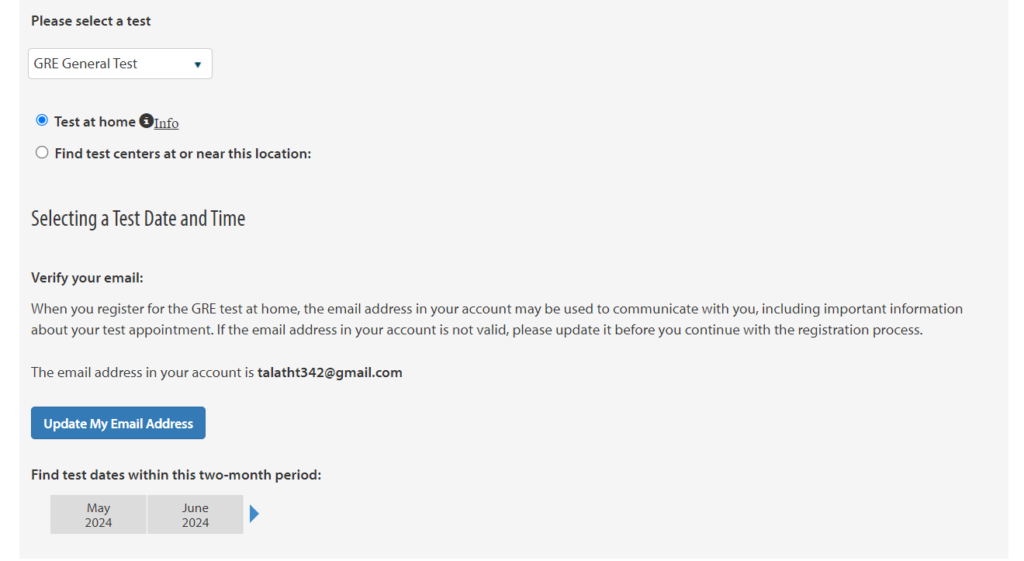
If choosing the at-home option, ensure you meet the technical requirements.
Step 4: Schedule your test

After choosing your test location or confirming your at-home setup, select a test date from the available options. Then, choose a time slot for the test based on availability.
Step 5: Confirm test details and accommodations
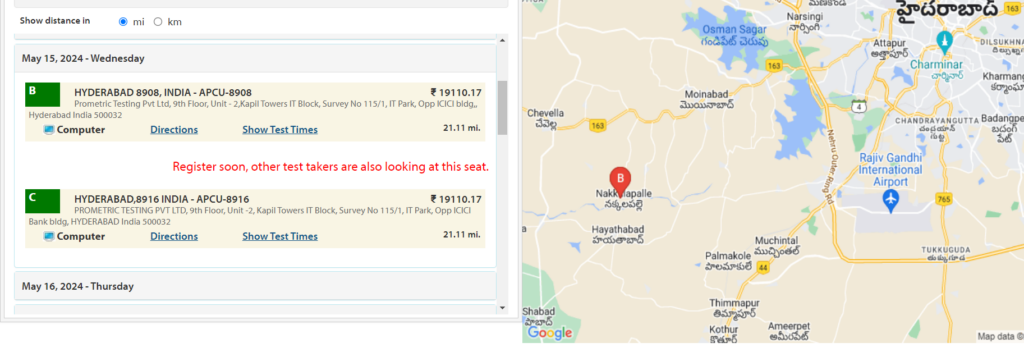
Once you click on the date, you’ll get more test details, such as test centers, dates, price of the test, direction of the test center, and directions and distance.
With the location or home setup decided, the next step is to choose your test time. Your test time will be shown based on your selected location and date. Pick a time that fits your schedule.

Step 5: Confirm test details and accommodations

Before you proceed, carefully review all the details of your test.
If you have special needs that require accommodations, this is the time to request them.
Double-check your personal information for accuracy and consider opting into additional services like the GRE Search Service, which can help schools find you based on your scores and preferences.
Step 6: Give your background information
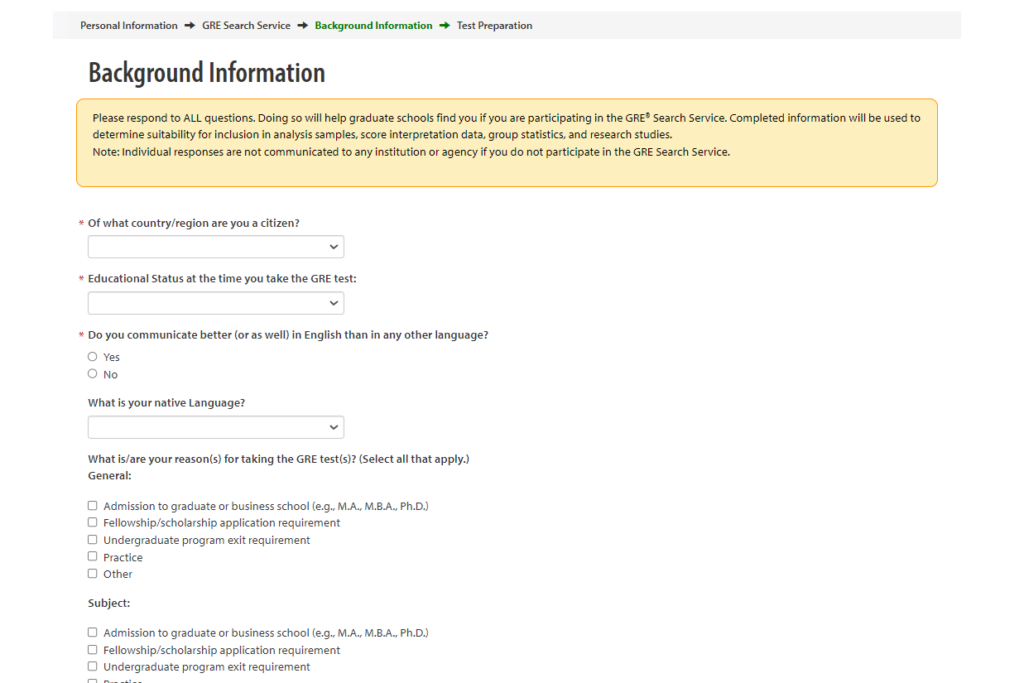
Fill out the background information with details like your citizenship, place of birth, intent of going abroad, course you’ll be pursuing, etc.
Step 7: Pay the registration fee
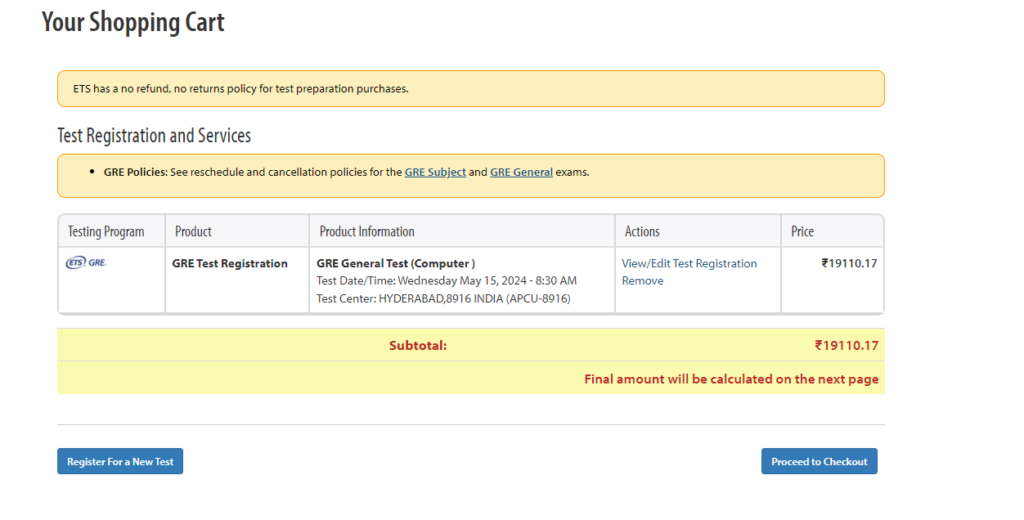
Finally, you’ll be redirected to the final window to pay your registration fee. Accept the terms and conditions and submit your payment.
Step 8: Finalize and pay your registration fee
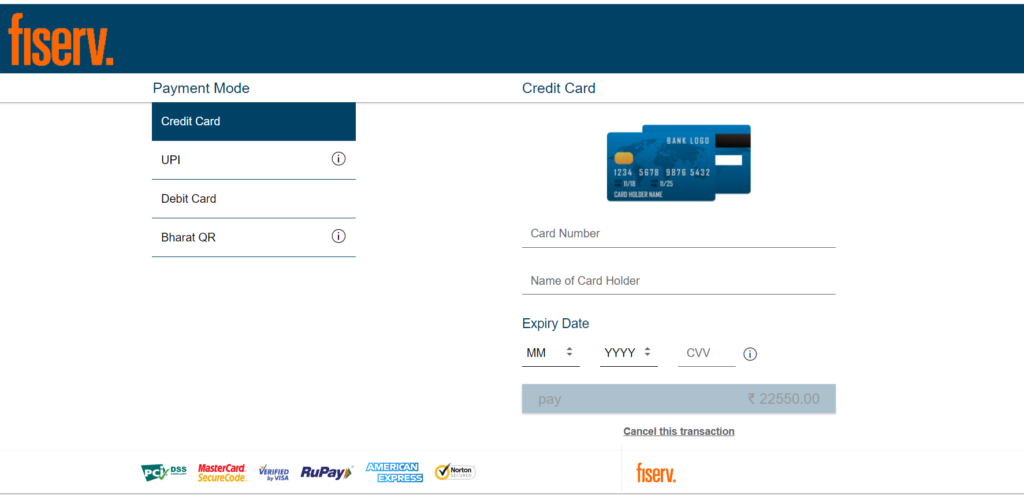
Image: Checkout page
Proceed with the payment, and then you will receive a confirmation page and an email with your test details and registration number. Save this information for your records.
You’ve successfully registered for the GRE test.
GRE 2025 exam preparation tips
To excel in your GRE preparation for 2024, it’s crucial to approach your studies methodically and thoughtfully. Avoid last-minute preparation by cramming up information; this can severely hamper your GRE preparation.
Here’s a structured plan to guide you:
Familiarize yourself with the test structure
To start, get to know the GRE inside out.
Understand the structure thoroughly. It will help you know what to expect and effectively tailor your study plan. You’ll be aware of each section’s format and types of questions to ensure no surprises on test day.
Select appropriate study materials
Choosing the right study materials is crucial to ace the GRE. You can start with official ETS resources like the preparation books and guides. You can find books for each section separately, as well as the writing test known as the Scoreit NOW online practice test.
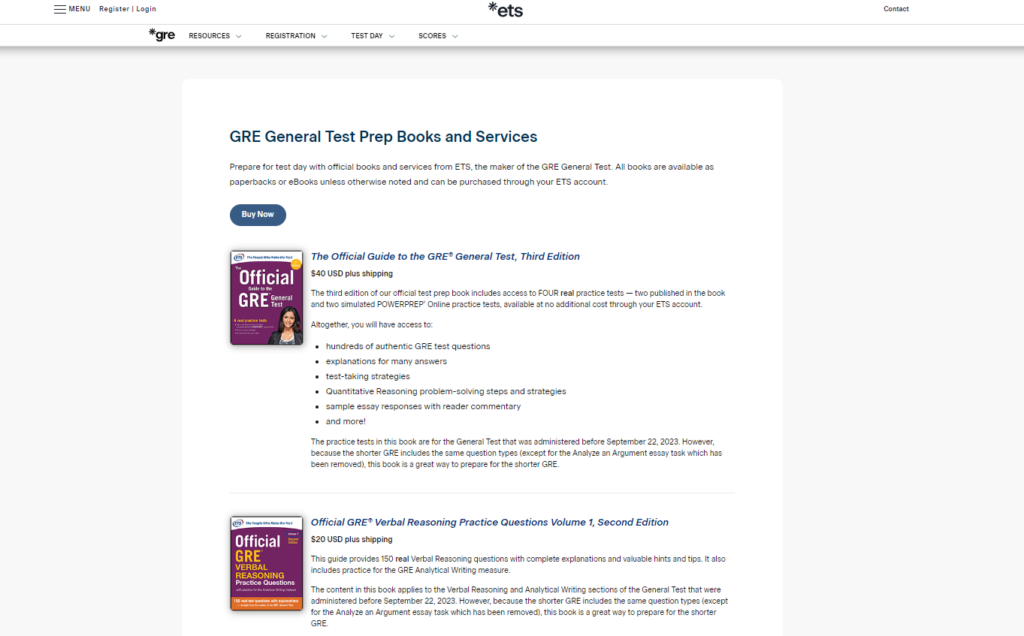
Take POWERPREP practice online tests
You can also take POWERPREP practice online tests that mirror the actual test conditions and are invaluable for practice.

Fortunately, you get free access to the POWERPREP Preview tool and POWERPREP online to help you power up your practice. Also, you can supplement your preparation with POWERPREP official practice tests containing real-test questions, explanations, and scores.
Implement timed practice for each section
Time management is key in the GRE. Start your preparation by focusing on one section and then proceeding to another. Make sure you use official GRE practice tests for each section.

You can download these free PDFs of sample questions and consistently practice to enhance accuracy as you progress. It helps to simulate real test conditions by timing your practice. This approach helps you maintain the quality of your answers while improving your speed, a critical skill for the actual exam day.
Take full-length practice tests
Make it a habit to take full-length practice exams regularly. These simulate the test-day environment and are essential for building your stamina.
After each test, thoroughly analyze your results to identify and learn from your mistakes, refining your strategy as you go.
Monitor your progress
Keep a close watch on your progress. Regularly assess your strengths and weaknesses and adjust your study plan accordingly. This continuous evaluation helps you spend more time on areas that need improvement while also honing your stronger skills.
Work on your weak areas and challenge your strong areas
Maintain a balanced approach in your preparation.
Dedicate time to strengthening your weak spots and challenging yourself in areas where you’re already strong. This strategy ensures you are well-prepared for all sections of the GRE.
Learn stress management techniques
Finally, integrate stress management techniques into your prep plan.
Also Read: How To Prepare For GRE in 2024 (Complete Strategy)
FAQs
Firstly, understand the test format of the GRE and then practice by gathering official ETS materials and reputable third-party resources. You can also sign up for GRE single test preparation materials to prepare the GRE thoroughly.
If you’re applying for the GRE in 2024 during the fall season, starting the process by early 2024 is ideal to ensure scores are ready well before fall application deadlines.
Some of the best GRE preparation materials include ETS’s official guides and POWERPREP tests. You can supplement it with Kaplan and Manhattan Prep books or additional practice.
A consistent practice schedule from 3 to 6 months can help you achieve higher scores on the GRE.
Try learning new vocabulary words and practicing reading comprehension daily. You can also use timed drills to improve speed and accuracy, which will improve your GRE verbal score and fluency in English.
Yes, you can retake the GRE after 21 days, up to five times within any rolling 12-month period.
Try taking regular breaks, physical exercise, and practicing mindfulness, as these effectively manage stress during GRE preparation.

















